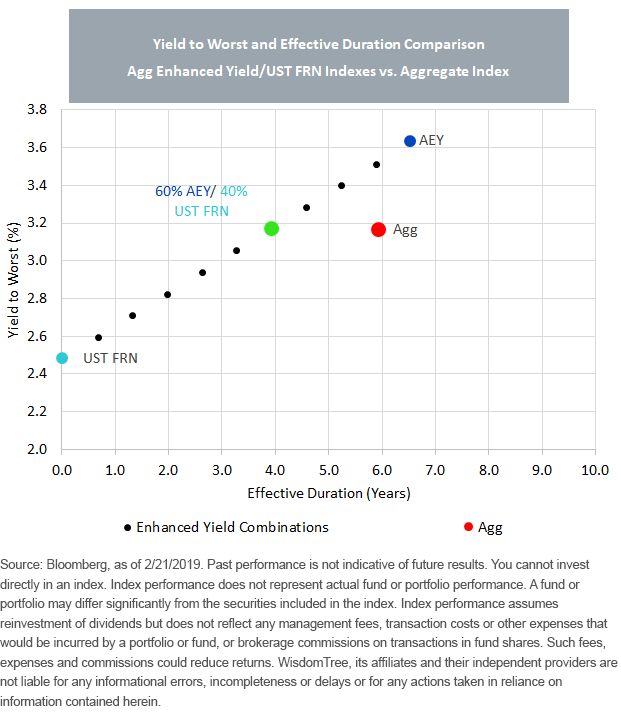Weighing In on Our Barbell Strategy


Unlike the previous two years, the 2019 outlook for fixed income has been fraught with confusion and uncertainty. Changing economic positions and attendant Federal Reserve (Fed) policy expectations have created this more challenging environment, and the lack of “fresh” economic data to begin the year—due to the partial government shutdown—has only added to this indecision. How, then, do investors navigate such a fixed income landscape? It is time to revisit the barbell strategy I first wrote about in my August 15, 2018, blog, “The Barbell Approach: A Time-Tested Fixed Income Strategy.”
As a reminder, a fixed income barbell is a strategy that essentially replicates the weightlifting apparatus. In other words, the investor utilizes two parts of the yield curve: on one side, the focus tends to be centered around an intermediate- or longer-duration vehicle, while the other end of the spectrum concentrates on a short-duration instrument. These two “weights” on the barbell serve two different purposes. The intermediate-/longer-duration aspect can help solve for income needs or total return considerations, while the short-duration investment serves as a “rate fulcrum.”

For definitions of terms in the chart, please click here.
In this blog post, I’ll provide an update on the two indexes we highlighted six months ago: The Bloomberg Barclays U.S. Aggregate Enhanced Yield Index (AEY) and the Bloomberg U.S. Treasury Floating Rate Bond Index (UST FRN). The latter serves as the short-duration weight of the barbell and is based on the 2-Year Treasury floating rate note. AEY is a yield-enhanced index which reweights the sectors of the Bloomberg Barclays U.S. Aggregate Bond Index (Agg) and serves as the longer-duration weight.
The accompanying graph illustrates how an investor can implement various allocations between these two “weights” of the barbell to seek the desired result and, in the case of our analysis, compare this result to the Agg. Interestingly, there has been a shift in weighting since I blogged on this topic last summer. At that time, the focus was on a 70%-AEY/30%-UST FRN combination, but the updated version now sees a potentially more desirable outcome in a 60%-AEY/40%-UST FRN mix. As of this writing, this “barbell” offers a yield of 3.17%, identical to the Agg, but it cuts the duration by two years versus the Agg.
The aforementioned shift is the by-product of the Fed’s two additional rate increases in September and December of last year, combined with the decline in yield levels that occurred in the intermediate/longer-term part of the curve over the last three months or so.
Conclusion
The WisdomTree Yield Enhanced U.S. Aggregate Bond Fund (AGGY), which seeks to track the Bloomberg Barclays U.S. Aggregate Enhanced Yield Index, and the WisdomTree Floating Rate Treasury Fund (USFR), which seeks to track the Bloomberg U.S. Treasury Floating Rate Bond Index, can be utilized as the two “weights” discussed here. The barbell strategy laid out in this blog offers investors a strategic solution designed to help fixed income investors navigate the choppy waters that could loom ahead, without making a “high-conviction bet” on where rates are headed in this uncertain landscape.
Unless otherwise noted, all data is from Bloomberg, as of February 21, 2019.
Important Risks Related to this Article
There are risks associated with investing, including possible loss of principal. Fixed income investments are subject to interest rate risk; their value will normally decline as interest rates rise. Fixed income investments are also subject to credit risk, the risk that the issuer of a bond will fail to pay interest and principal in a timely manner or that negative perceptions of the issuer’s ability to make such payments will cause the price of that bond to decline. Investing in mortgage- and asset-backed securities involves interest rate, credit, valuation, extension and liquidity risks and the risk that payments on the underlying assets are delayed, prepaid, subordinated or defaulted on. Securities with floating rates can be less sensitive to interest rate changes than securities with fixed interest rates, but may decline in value. The issuance of floating rate notes by the U.S. Treasury is new and the amount of supply will be limited. The value of an investment in the Funds may change quickly and without warning in response to issuer or counterparty defaults and changes in the credit ratings of the Funds’ portfolio investments. Due to the investment strategy of these Funds, they may make higher capital gain distributions than other ETFs. Please read each Fund’s prospectus for a discussion of risks.


